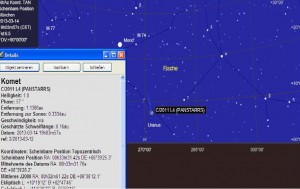To see a bright comet with the naked eye or binocular in the night sky is one of the most impressive experiences of amateur astronomers. Under the current weather condidtion it could happen in March again. On June 6, 2011 Hawaii discovered Comet C/2011 L4 (PANSTARRS) moves in the direction of Sun he resides but deep in the southern sky in February, so that he only once not can be observed in Central Europe. On 5 March, the Comet reached closest to Earth – with 1,1AE but is a relatively large distance. Even then, he is not observable in Europe because the apparent distance to the Sun is in a southeasterly direction only 17.5 °.
First, let me stress Comet PanSTARRS is not likely to be nearly as bright as originally predicted – but it still should be a nice comet, especially when viewed with binoculars. And remember – we have another comet due in November/December that should be better. However, with comets we can only make educated guesses – they can – and have – surprised the experts over the years, sometimes under performing, sometimes over performing.
Quick Observing Guide:
- to observe comet at their best, hope for clear skies on March 12 – and some special comet luck
- to observe Comet PanSTARRS it may be visible the week beginning March 12 will probably give the best opportunity for observers in mid-northern latitudes.
 A comet is a “dirty snowball” that “melts” when it gets near the sun, giving off what can be a spectacular trail (tail) of tiny dust particles that reflect sunlight. When we think of a comet we are usually thinking of seeing one with such a tail.
A comet is a “dirty snowball” that “melts” when it gets near the sun, giving off what can be a spectacular trail (tail) of tiny dust particles that reflect sunlight. When we think of a comet we are usually thinking of seeing one with such a tail.
Comet PanSTARRS will change position slightly each night, drawing away from the Sun.
The same basic requirements fit Comet PanSTARRS – you need a good view to the west with an unobstructed horizon, at least for the early – and probably best – views. While it may be visible to the naked eye, the best guess is this will be bets seen in binoculars. So by all means, break out the binoculars! You don’t need any thing special – ordinary, low-power ones will do, though if you have large astronomical binoculars, all the better. And while you will be searching for the comet in the early twilight, do be careful. Wait until about 15 minutes after sunset before scanning the western horizon for it. At all cost, avoid looking with your binoculars at the sun, as that will seriously damage your eyes.
You need to scan left where the sun set. I have seen PANSTARRS on Friday the 15th and Tuesday the 19th with binoculars and fairly ok circumstances. It was a perfect clear night, however the comet sets in the West, so you have to trade rest light of the sunset and the mist on the horizon if it gets to low.I observed in a park without direct light close to my house and had to avoid light pollution from a tennis court by moving, that some trees blocked the light. It is nice, with straight up tail but not really impressive. I could follow about 30 minutes with Fujinon 10×50 FMTR-SX but not with naked eye. On all other day the weather or the horizon was cloudy so far.
Source http://www.interstellarum.de/


